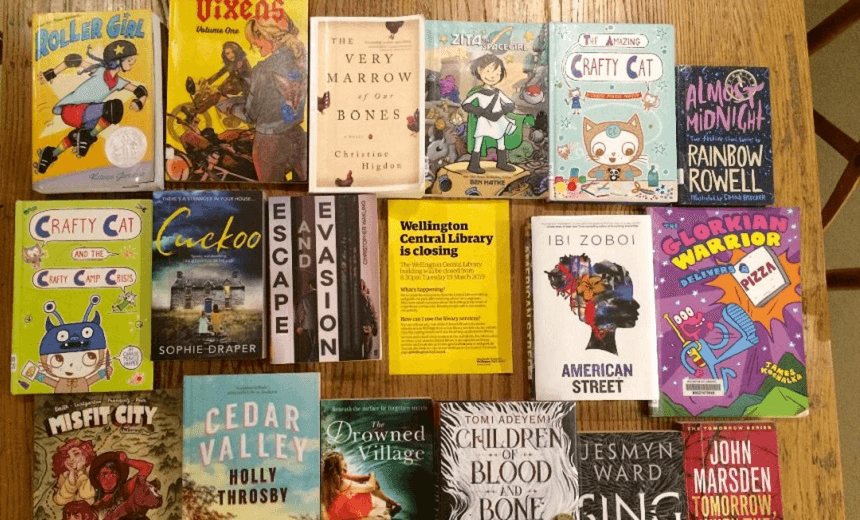The sudden closure of Wellington’s Central Library was a shock to residents in the capital. Gem Wilder reflects on her love for the library and her hopes for its future.
I received the news via the Wellington City Council twitter account, posted at 2:50pm on Tuesday afternoon: Wellington’s Central Library building will be closed from 8.30pm Tuesday 19 March 2019 until further notice.
It’s been an awful week for New Zealanders, so it’s perhaps no surprise that heightened emotions meant this news left many Wellingtonians feeling bereft. Libraries are, after all, community hubs.
Following tweets stated that the decision to close was made “after receiving advice from engineers that the building has structural vulnerabilities…” We should have perhaps seen this coming, with the nearby Old Town Hall currently in the midst of a long term strengthening project, and more recently, the demolition of the section of the building that spanned the space between the Central Library and the Council buildings, above the entrance to Civic Square. It seems inevitable, now, that the library would follow suit.
The Central Library has recently become my local, and my daughter and I had developed a routine of going there after I picked her up from school on a Friday afternoon. We’d go straight to the children’s section, where she would pick out a selection of comics and graphic novels, and I’d set her up on one of the big cosy armchairs to begin reading them while I wandered the shelves, picking out my own selections. We would always choose more books than it is comfortable to carry, there would be an argument through gritted teeth at the check out machine where she would suddenly decide she wanted just three more books, at least one wouldn’t scan properly and would need to be taken to the help desk to be issued, and eventually, weighted down by our supply of reading material, we’d be on our way.
These trips always brought us into contact with a wide cross section of the community.
There would be toddlers playing in the kids section while their caregivers read them picture books, or just sat back for a welcome breather in a safe and welcoming space. The desks that lined the enormous stretch of windows along the length of the back wall of the library would be filled with students, studying or being tutored. There would be people reading the paper, senior citizens on their way from the drop-in centre, businesspeople returning books on a quick break from work, people heading to the Citizen’s Advice Bureau, and Clarks cafe upstairs, feeding and caffeinating the hordes.
Sometimes, on our way to the library, my daughter would think about a particular subject she wanted books on, and as soon as we’d arrive she would confidently approach a desk to ask a librarian to help her find her desired books. I’ve always told her that librarians are there to help, and they have always responded enthusiastically to whatever challenges my girl has thrown at them. If she asks for a book about treasure hunts, they’ll lead her to map books and maze books and pirate books, comics, non-fiction, picture books. They cover all the bases and ensure she is satisfied.
Librarians are truly wonderful.
Think about it. Can you imagine the variety of questions a librarian would have to answer on any given work day? They are keepers of knowledge, they know how to access information, and they always seem to find the answers to whatever you’re asking them so damn quickly. It’s magical.
Once I’d recovered from my own sadness at the news that my Friday afternoon library routine was about to change, my thoughts were with the librarians and staff of Wellington Central Library. If I’m feeling upset about this closure, I can only imagine how stressful and upsetting it must be for them right now. The over 100 library staff were informed of the closure at the same time as the public and the media on Tuesday afternoon. Wellington City Council have said all staff will keep their jobs during this closure, and were seeking to find them alternative spaces for them to work from.
If the Central Library staff want advice on how to cope with the sudden change, they need only look to their fellow library workers up the road in Upper Hutt. The Upper Hutt Central Library was closed in similarly sudden circumstances in February 2018. They set up a pop-up library in a temporary venue which, while welcoming, was not ideal, given that libraries are generally purpose built with very specific needs and requirements. Patrons were delighted when, on March 11, the library threw open its doors once more.
I trust that Wellington City Council will find a temporary venue to operate out of over the period of strengthening the Central Library building. Those of us who have experienced the kind of upheaval and uncertainty the Central Library staff are going through will understand how stressful this time will be for everyone involved.
Be patient with the staff who may be working out of suburban libraries they’ve never set foot in before.
Be patient with council staff relaying information and trying to answer questions when so much is as yet unknown.
Take advantage of the reissuing Wellington Libraries have set up automatically on all books currently issued, and finish that tome you thought you were going to get late fees on.
If you run a space that can be used by community groups or studying students, make sure to spread the word about it.
Now, as much as ever, we need welcoming community spaces, where all walks of life know they will be accepted. I’d love to see Wellingtonians get creative and fill the void left by the loss of the Central Library.



